About Email & Web Hosting
The email landscape has changed considerably in just the last few years in response to the continued rise of spam, malware and identity theft (phishing). In the past, most hosting companies have provided email services along with web hosting. More recently, some hosting companies have discontinued email services altogether, while others have spun them off into a separate service. When email and web hosting are combined, it’s important to be aware of the limitations of using the same platform for both services.
Spam protection and email deliverability: two sides of the same coin
Nobody likes spam. These intrusions into our inboxes cause unwanted distraction and saps productivity. That’s why robust spam protection is so important, to accurately detect spam (without false positives) and then separate it from the email that we actually want to see. Make no mistake, this is a hard technology to get right. A good spam filter must simultaneously protect against:
- Messages from known spammers (who are not friends of ours)
- Messages that look like spam (but are not marketing messages that we actually want)
- Messages that contain malicious links or viruses
In addition, the best anti-spam systems are continuously learning about new external threats, as well as your own personal preferences. The unfortunate fact is that standalone anti-spam software, whether installed on a server or locally on your own computer, will probably never be as effective as the cloud based offerings from Google and Microsoft, which can leverage machine learning from hundreds of millions of other users on their platforms.
Now consider the reverse process, when sending email. Your message must pass through the same anti-spam screening, in order to be successfully delivered. One of the biggest obstacles to deliverability is the “reputation” of the sending mail server. If the IP address of your server (or the network to which your server is attached) gets added to an email “block list”, it can result in messages being sent to the recipient’s spam folder or not being delivered at all. Here are just a few of the things that can land you on a block list:
- Server DNS records for authentication (SPF or DKIM) missing or misconfigured
- Server IP address already listed on a block list
- Mismatch between sender FROM domain and server domain
- Server reverse lookup not configured
Many of these items are beyond the control of the user, who must rely on the hosting company to protect the reputation of their email servers. This is a specialized and time consuming job, so it may not get the highest priority. At most web hosting companies, thousands of domains may share a range of IP addresses, so even if your behavior is exemplary, that of your neighbor can get the whole range blocked.
The dangers of email forwarding
It seems like a great convenience, being able to forward email sent to one email address to another. For example, mail sent to info@yourbusiness.com is forwarded to yourpersonalemail@gmail.com. But here’s the problem: info@yourbusiness.com might be getting a ton of spam, which it is blindly forwarding to Gmail. Gmail sees the spam as coming from the server @yourbusiness.com and puts your domain on a block list, which might spread to other email providers, and all of a sudden mail sent from your business domain is bouncing back to you.
A much better solution is to hold the mail in a mailbox on the server and check it using whatever software or app that you use to read email. Gmail works especially well for this, as it allows connections to up to five external email accounts.
Hosting business critical email
Considering all of the complexities of email hosting mentioned above, I find it hard to recommend anything other than a dedicated email service – separate from web hosting – for business email. These services are focused on email and have the resources to protect the reputation of their servers to maximize deliverability. Most also have generous storage space and excellent webmail interfaces, allowing full access to email from any web browser.
My personal preference is Google Workspace but there are also excellent offerings from Microsoft, Zoho, Rackspace and others. It’s also worth mentioning that Google is recognized as the gold standard for spam filtering. If you’ve been struggling with spam, using Gmail will be a revelation.
These services are intended to be used with email addresses within your business domain. There will be some configuration of DNS records required and whoever manages your website should be able to help with that. There may also be some coordination needed to migrate the mail accounts if you have previously been using your web host for email.
I hope this provides a better understanding of the capabilities and limitations of email on web hosting platforms. If there’s anything else that I can address, please leave a comment below.


